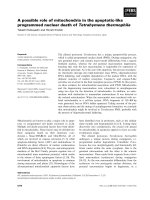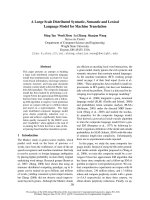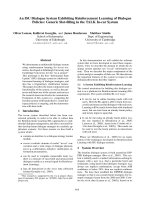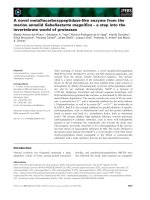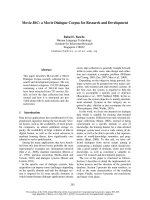Báo cáo khoa học: "a Chat-oriented Dialogue System based on the Vector Space Model" ppt
Bạn đang xem bản rút gọn của tài liệu. Xem và tải ngay bản đầy đủ của tài liệu tại đây (134.33 KB, 6 trang )
Proceedings of the 50th Annual Meeting of the Association for Computational Linguistics, pages 37–42,
Jeju, Republic of Korea, 8-14 July 2012.
c
2012 Association for Computational Linguistics
IRIS: a Chat-oriented Dialogue System based on the Vector Space Model
Rafael E. Banchs Haizhou Li
Human Language Technology Human Language Technology
Institute for Infocomm Research Institute for Infocomm Research
Singapore 138632
Singapore 138632
Abstract
This system demonstration paper presents
IRIS (Informal Response Interactive Sys-
tem), a chat
-oriented dialogue system based
on the vector space model framework. The
system belongs to the class of example-
based dialogue systems and builds its chat
capabilities on a dual search strategy over a
large collection of dialogue samples. Addi-
tional strategies allowing for system adap-
tation and learning implemented over the
same vector model space framework are
also described and discussed.
1 Introduction
Dialogue systems have been gaining popularity re-
cently as the demand for such kind of applications
have increased in many different areas. Addition-
ally, recent advances in other related language
technologies such as speech recognition, discourse
analysis and natural language understanding have
made possible for dialogue systems to find practi-
cal applications that are commercially exploitable
(Pieraccini et al., 2009; Griol et al., 2010).
From the application point of view, dialogue
systems can be categorized into two major classes:
task-oriented and chat-oriented. In the case of task-
oriented dialogue systems, the main objective of
such a system is to help the user to complete a task,
which typically includes booking transportation or
accommodation services, requesting specific infor-
mation from a service facility, etc. (Busemann et
al., 1997; Seneff and Polifroni, 2000; Stallard,
2000). On the other hand, chat-oriented systems
are not intended to help the user completing any
specific task, but to provide a means for participa-
ting in a game, or just for chitchat or entertain-
ment. Typical examples of chat-oriented dialogue
systems are the so called chat bots (Weizenbaum,
1966; Ogura et al., 2003, Wallis, 2010).
In this paper, we introduce IRIS (Informal Res-
ponse Interactive System), a chat-oriented dialogue
system that is based on the vector space model
framework (Salton et al., 1975; van Rijsbergen,
2005). From the operational point of view, IRIS
belongs to the category of example-based dialogue
systems (Murao et al., 2003). Its dialogue strategy
is supported by a large database of dialogues that is
used to provide candidate responses to a given user
input. The search for candidate responses is per-
formed by computing the cosine similarity metric
into the vector space model representation, in
which each utterance in the dialogue database is
represented by a vector.
Different from example-based question answer-
ing systems (Vicedo, 2002; Xue et al., 2008), IRIS
uses a dual search strategy. In addition to the cur-
rent user input, which is compared with all existent
utterances in the database, a vector representation
of the current dialogue history is also compared
with vector representations of full dialogues in the
database. Such a dual search strategy allows for in-
corporating information about the dialogue context
into the response selection process.
The rest of the paper is structured as follows.
Section 2 presents the architecture of IRIS as well
as provides a general description of the dataset that
has been used for its implementation. Section 3
presents some illustrative examples of dialogues
generated by IRIS, and Section 4 presents the main
conclusions of this work.
37
2 The IRIS Implementation
In this section we first provide a detailed descrip-
tion of the IRIS architecture along with the most
relevant issues behind its implementation. Then,
we describe the specific dialogue dataset that sup-
ports the IRIS implementation.
2.1 Architecture
As already mentioned, IRIS architecture is heavily
based on a vector space model framework, which
includes a standard similarity search module from
vector-based information retrieval systems (Salton
and McGill, 1983). However, it also implements
some additional modules that provide the system
with capabilities for automatic chatting.
Figure 1 depicts a block diagram that illustrates
the main modules in the IRIS architecture. As seen
from the picture, the whole system comprises se-
ven processing modules and three repositories.
Figure 1: General block diagram for IRIS
The main operation of IRIS can be described as
follows. When a new dialogue starts, the control of
the dialogue is passed from the dialogue manage-
ment module to the initiation/ending module. This
module implements a two-state dialogue strategy
which main objectives are: first, to greet the user
and self-introduce IRIS and, second, to collect the
name of the user. This module uses a basic parsing
algorithm that is responsible for extracting the
user’s name from the provided input. The name is
the first vocabulary term learned by IRIS, which is
stored in the vocabulary learning repository.
Once the dialogue initiation has been concluded
the dialogue management system gains back the
control of the dialogue and initializes the current
history vector. Two types of vector initializations
are possible here. If the user is already know by
IRIS, it will load the last stored dialogue history
for that user; otherwise, IRIS will randomly select
one dialogue history vector from the dialogue data-
base. After this initialization, IRIS prompts the
user for what he desires to do. From this moment,
the example-based chat strategy starts.
For each new input from the user, the dialogue
management module makes a series of actions that,
after a decision process, can lead to different types
of responses. In the first action, the dynamic repla-
cement module searches for possible matches bet-
ween the terms within the vocabulary learning
repository and the input string. In a new dialogue,
the only two terms know by IRIS are its own name
and the user name. If any of this two terms are
identified, they are automatically replaced by the
placeholders <self-name> and <other-name>, res-
pectively.
In the case of a mature dialogue, when there are
more terms into the vocabulary learning repository,
every term matched in the input is replaced by its
corresponding definition stored in the vocabulary
learning database.
Just after the dynamic replacement is conducted,
tokenization and vectorization of the user input is
carried out. During tokenization, an additional
checking is conducted by the dialogue manager. It
looks for any adaptation command that could be
possibly inserted at the beginning of the user input.
More details on adaptation commands will be
given when describing the style/manner adaptation
module. Immediately after tokenization, unknown
vocabulary terms (OOVs) are identified. IRIS will
consider as OOV any term that is not contained in
either the dialogue or vocabulary learning data-
bases. In case an OOV is identified, a set of heuris-
tics (aiming at avoiding confusing misspellings
with OOVs) are applied to decide whether IRIS
should ask the user for the meaning of such a term.
38
If IRIS decides to ask for the meaning of the
term, the control of the dialogue is passed to the
vocabulary learning module which is responsible
for collecting the meaning of the given term from
the user or, alternatively, from an external source
of information. Once the definition is collected and
validated, it is stored along with the OOV term into
the vocabulary learning repository. After comple-
ting a learning cycle, IRIS acknowledges the user
about having “understood” the meaning of the term
and control is passed back to the dialogue manage-
ment module, which waits for a new user input.
If IRIS decides not to ask for the meaning of the
OOV term, or if no OOV term has been identified,
vectorization of the user input is completed by the
vector similarity modules and similarity scores are
computed for retrieving best matches from the
dialogue database. Two different similarity scores
are actually used by IRIS. The first score is applied
at the utterance level. It computes the cosine
similarities between the current user input vector
and all single utterances stored in the database.
This score is used for retrieving a large amount of
candidate utterances from the dialogue database,
generally between 50 and 100, depending on the
absolute value of the associated scores.
The second score is computed over history
vectors. The current dialogue history, which is
available from the current history repository, inclu-
des all utterances interchanged by the current user
and IRIS. In other to facilitate possible topic chan-
ges along the dialogue evolution, a damping or
“forgetting” factor is used for giving more impor-
tance to the most recent utterances in the dialogue
history. A single vector representation is then com-
puted for the currently updated dialogue history
after applying the damping factor. The cosine
similarity between this vector and the vector repre-
sentations for each full dialogue stored in the dia-
logue database are computed and used along with
the utterance-level score for generating a final rank
of candidate utterances. A log-linear combination
scheme is used for combining the two scores. The
dialogue management module randomly selects
one of the top ranked utterances and prompts back
to the user the corresponding reply (from the dia-
logue database) to the wining utterance.
Just immediately before prompting back the res-
ponse to the user, the dynamic replacement module
performs an inverse operation for replacing the two
placeholders <self-name> and <other-name>, in
case they occur in the response, by their actual
values.
The final action taken by IRIS is related to the
style/manner adaptation module. For this action to
take place the user has to include one of three pos-
sible adaptations commands at the beginning of
her/his new turn. The three adaptation commands
recognized by IRIS are: ban (*), reinforce (+), and
discourage (–). By using any of these three charac-
ters as the first character in the new turn, the user is
requesting IRIS to modify the vector space repre-
sentation of the previous selected response as
follows:
Ban (*): IRIS will mark its last response as a
prohibited response and will not show such
response ever again.
Reinforce (+): IRIS will pull the vector space
representation of its last selected utterance
towards the vector space representation of the
previous user turn, so that the probability of
generating the same response given a similar
user input will be increased.
Discourage (–): IRIS will push the vector
space representation of its last selected utter-
ance apart from the vector space represen-
tation of the previous user turn, so that the
probability of generating the same response
given a similar user input will be decreased.
2.2 Dialogue Data Collection
For the current implementation of IRIS, a subset of
the Movie-DiC dialogue data collection has been
used (Banchs, 2012). Movie-DiC is a dialogue
corpus that has been extracted from movie scripts
which are freely available at The Internet Movie
Script Data Collection ( />).
In this subsection, we present a brief description on
the specific data subset used for the implementa-
tion of IRIS, as well as we briefly review the
process followed for collecting the data and ex-
tracting the dialogues.
First of all, dialogues have to be identified and
parsed from the collected html files. Three basic
elements are extracted from the scripts: speakers,
utterances and context. The speaker and utterance
elements contain information about the characters
who speak and what they said at each dialogue
turn. On the other hand, context elements contain
all the additional information (explanations and
descriptions) appearing in the scripts.
39
The extracted dialogues are stored into a data
structure such that the information about turn se-
quences within the dialogues and dialogue sequen-
ces within the scripts are preserved.
Some post-processing is also necessary to filter
out and/or repair the most common parsing errors
occurring during the dialogue extraction phase.
Some of these errors include: bad script formatting,
same-speaker turn continuations, explanatory notes
inserted within the turns, misspelling of names in
the speaker headers, changes in the encoding for-
mat, etc.
The final dialogue collection used in the IRIS
implementation consists of dialogues from 153
movie scripts, mainly belonging to the comedy,
action and family genres. Table 1 summarizes the
main statistics of the resulting dataset.
Total number of movie scripts 153
Total number of dialogues 24,265
Total number of speaker turns 159,182
Average amount of dialogues per movie 158.59
Average amount of turns per dialogue 6.56
Total number of running words 1,670,879
Overall vocabulary size 34,903
Table 2: Main statistics of the movie dialogue
dataset used in the IRIS implementation
For each turn in the dialogue collection, a vector
space model representation was constructed. For
this, the standard bag-of-words weighting scheme
known as TF-IDF was used (Spark, 1972; Salton
and Buckley, 1988).
Before performing the vectorization, word toke-
nization was conducted. In this step, all punctua-
tion marks were removed, with the exception of
the question “?” and exclamation “!” marks. Simi-
larly, all other non-alphanumeric characters occur-
ring in the utterances were removed as well. Also
during the tokenization phase, all self-references to
current speaker names in the utterances were re-
placed by the <self-name> placeholder, as well as
all references to the names of other speakers
participating in the same dialogue were replaced
by the <other-name> place-holder.
Finally, a vector space model representation was
also computed for each full dialogue in the collec-
tion. For this bag-of-words model at the dialogue
level, both utterance and context information were
taken into account. Again, the TF-IDF weighting
scheme was used.
3 Some Dialogue Examples
In this section we show some real examples of
interactions between IRIS and human users. First,
we present some interesting examples of good per-
formance, as well as illustrate some of the learning
capabilities of IRIS. Then, we present some of the
common failures which identify specific points of
attention for further improvements.
3.1 Good Performance Examples
Our first example illustrates the beginning of a
typical chat session between IRIS and a new user.
This example is depicted in Table 2.
# Spkr. Turn
1 IRIS Hi, I’m IRIS… What’s your name?
2 USER Hi Iris, I am Peter
3 IRIS Nice name Peter What do you want to talk
about?
4 USER Sports?
5 IRIS How come in all that time I was trying to get
you a date, you never asked me out?
6 USER ok, do you want to go for dinner tonight?
7 IRIS Yes.
8 USER What kind of food do you like?
9 IRIS Anything but guts and mushrooms.
10 USER Ok pick you up at seven!
11 IRIS Ok. Pick me up at seven.
Table 2: Beginning of a chat session between IRIS
and a new user
For the dialogue depicted in Table 2, turn num-
bers 1, 2 and 3 are processed by the dialogue intia-
tion/ending module. The example-based dialogue
management strategy starts from turn 4 onwards.
Notice that as far as this is a new user, not previous
dialogue history exists, so in this case a random
history vector has been selected and instead of
focusing in the sports topic suggested by the user,
IRIS “takes the initiative” of asking for a date.
In our second example, which is presented in
Table 3, we illustrate the beginning of a typical
chat session between IRIS and a returning user.
For this particular user, her last interaction with
IRIS was about sports.
Similar to the previous example, turn 1 is pro-
cessed by the dialogue intiation/ending module and
the example-based dialogue management strategy
starts from turn 2 onwards. In this particular case,
IRIS is much more centered on the sports topic as
this context information has been already provided
40
by the stored dialogue history of the previous chat
session with this particular user.
# Spkr. Turn
1 IRIS Hey, Helen welcome back! How are you
doing?
2 USER fine and you?
3 IRIS Is there more?
4 USER Yes, I finally went to that tennis match I told
you the last time.
5 IRIS The match!
6 USER Yes, have you seen some sports recently?
7 IRIS I hate sports.
Table 3: Beginning of a chat session between IRIS
and a returning user
In our third example, which is presented in
Table 4, we illustrate the learning of a new vocabu-
lary word by IRIS. In this example, when the un-
known term paella is detected, the control of the
dialogue is passed to the vocabulary learning mo-
dule, which takes care of turns 7, 8, 9 and 10.
# Spkr. Turn
1 USER do you cook anything Iris?
2 IRIS Eggs.
3 USER ha ha ha!
4 IRIS Ha-ha-ha! Ha-ha-ha!
5 USER Can you cook anything else?
6 IRIS Do you cook?
7 USER Paella
8 IRIS What the hell is that????
9 USER It is a Spanish food. Yellow rice with some
seafood on it.
10 IRIS Ok, I see thanks!
11 USER So, do you want some paella today?
12 IRIS Well, it beats working in a seafood restaurant
Table 4: Chat segment in which IRIS learns the
new vocabulary term paella
Notice that when the user asks IRIS about
having some paella today, IRIS is already able to
associate it with seafood as it was stated in the
user’s provided definition. The process actually
occurs as follows: after tokenization, but before
vectorization of the user input in turn 11, the
dynamic replacement module substitutes the term
paella by its definition, which has been previously
stored in the vocabulary learning repository when
turn 9 was processed. The actual user input that is
finally vectorized in turn 11 is the following one:
so do you want some it is a spanish food yellow
rice with some seafood on it today ?, which is the
utterance used by IRIS to retrieve and select the
response it provides in turn 12.
3.2 Common Failure Examples
In this subsection we focus our attention in the
most common failures exhibited by IRIS. Some of
these failures put in evidence specific points of
attention that should be taken into account for
further improvements of the system.
Our first example illustrates the problem of IRIS
lack of consistency in issues for which consistent
answers are required. Two specific chat segments
in which IRIS provides inconsistent responses are
presented in Table 5.
# Spkr. Turn
1 USER how old are you Iris?
2 IRIS I'm thirteen, how old are you?
3 USER I am 40
4 IRIS Only I did better 40 crates a day.
5 USER how old are you Iris?
6IRISTen.
# Spkr. Turn
1 USER Yes, have you seen some sports recently?
2 IRIS I hate sports.
3 USER Really, what about soccer?
4 IRIS I'd sooner watch soccer.
5 USER what do you prefer soccer or football?
6 IRIS Football is my life.
Table 5: IRIS incapability to being consistent
The first example presented in Table 5 constitu-
tes a serious consistency problem. In this case IRIS
has reported two different ages in the same chat
session. The second case, although not so serious
as the previous one, also constitutes a consistency
failure. In this case IRIS states Football is my life
just two turns after saying I hate sports.
Our second example, which is presented in Ta-
ble 6, illustrates a problem derived from the noise
that is still present in the dataset.
# Spkr. Turn
1 IRIS You watching the ballgame?
2 USER No
3 IRIS Bianca stares at him for a moment.
Table 6: Example of noise in the dialogue dataset
In the particular example illustrated in Table 6,
as seen from turn 3, a context element has been
41
mistakenly stored in the data collection as an
utterance during the dataset preparation phase.
Several problems similar to this one, which are
related to noise in the database, have been detected
already. To tackle this problem we need to refine
the parsing and post-processing algorithms used
during the dialogue dataset construction phase.
4 Conclusions and Future Work
In this paper, we have presented IRIS (Informal
Response Interactive System), a chat-oriented dia-
logue system that is based on the vector space
model framework. The system belongs to the class
of example-based dialogue systems and builds its
chat capabilities on a dual search strategy over a
large collection of movie dialogues.
Additional strategies allowing for system adap-
tation and learning have been also implemented
over the same vector space model framework.
More specifically, IRIS is capable of learning new
vocabulary terms and semantically relating them to
previous knowledge, as well as adapting its dia-
logue decisions to some stated user preferences.
We have also described the main characteristics
of the architecture of IRIS and the most important
functions performed by each of its constituent
modules. Finally, we have provided some exam-
ples of good chat performance and some examples
of the common failures exhibited by IRIS.
As future work, we intend to improve IRIS per-
formance by addressing some of the already identi-
fied common failures. Similarly, we intend to aug-
ment IRIS chatting capabilities by extending the
size of the current dialogue database and integra-
ting a strategy for group chatting.
Acknowledgments
The authors would like to thank the Institute for
Infocomm Research for its support and permission
to publish this work.
References
Banchs R E (2012) Movie-DiC: a movie dialogue cor-
pus for research and development. In Proc. of the 50
th
Annual Meeting of the ACL.
Busemann S, Declerck T, Diagne A, Dini L, Klein J,
Schmeier S (1997) Natural language dialogue service
for appointment scheduling agents. In Proc. of the 5
th
Conference on Applied NLP, pp 25-32.
Griol D, Callejas Z, Lopez-Cozar R (2010) Statistical
dialog management methodologies for real applica-
tions. In Proc. of SIGDIAL’10, pp 269-272.
Murao H, Kawaguchi N, Matsubara S, Yamaguchi Y,
Inagaki Y (2003) Example-based spoken dialogue
system using WOZ system log. In Proc. of the 4
th
SIGDIAL, pp 140-148.
Ogura K, Masuda T, Ishizaki M (2003) Building a new
Internet chat system for sharing timing information.
In Proc. of the 4
th
SIGDIAL, pp 97-104.
Pieraccini R, Suendermann D, Dayanidhi K, Liscombe J
(2009) Are we there yet? Research in commercial
spoken dialog systems. In Proc. of TSD’09, pp 3-13.
Salton G, Wong A, Yang C (1975) A vector space mo-
del for automatic indexing. Communications of the
ACM 18(11):613-620.
Salton G, McGill M (1983) Introduction to modern
information retrieval. McGraw-Hill.
Salton G, Buckley C (1988) Term-weighting approa-
ches in automatic text retrieval. Information Proces-
sing & Management 24(5):513-523
Seneff S, Polifroni J (2000) Dialogue management in
the Mercury flight reservation system. In Proc. of the
ANLP-NAACL 2000 Workshop on Conversational
Systems, pp 11-16.
Spark K (1972) A statistical interpretation of term speci-
ficity and its application in retrieval. Journal of Do-
cumentation 28(1):11-21
Stallard D (2000) Talk’n’travel: a conversational system
for air travel planning. In Proc. of the 6
th
Conference
on Applied NLP, pp 68-75.
van Rijsbergen C (2005) A probabilistic logic for infor-
mation retrieval. In Advances in Information Retrie-
val, Lecture Notes in Computer Science 3408:1-6.
Vicedo J (2002) SEMQA: A semantic model applied to
question answering systems. PhD Thesis, University
of Alicante.
Wallis P (2010) A robot in the kitchen. In Proceedings
of the ACL 2010 Workshop on Companionable Dia-
logue Systems, pp 25-30.
Weizenbaum J (1966) ELIZA – A computer program
for the study of natural language communication be-
tween man and machine. Communications of the
ACM 9(1):36-45.
Xue X, Jeon J, Croft W (2008) Retrieval models for
question and answer archives. In Proc. of the 31
st
Annual International ACM SIGIR Conference on
R&D in Information Retrieval, pp 475-482.
42


